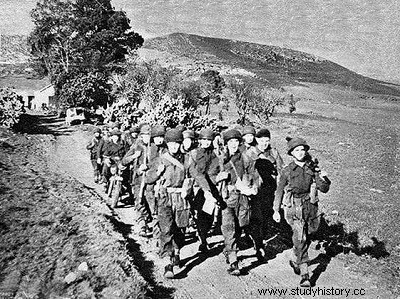
Resourceful, these paratroopers found an Italian motorcycle with sidecar in working order; using the railway line as a roadway, bouncing at breakneck speed on the sleepers, they managed to evacuate the two wounded at night to Sidi Nisr, where they received first aid. Hill had three bullets in the chest, and Captain Whitelock two projectiles in the neck. Both survived.
This series of successes had important results. With the French having decided to join the Allied side, General Eisenhower found himself relieved of one of his most pressing concerns. On the other hand, the Germans who were hounded were prevented from establishing a line of posts as close as possible to the Algerian border. After reinforcement, such a device would indeed have constituted a real defensive perimeter behind which the reconditioning of their forces would have continued.
In addition, the 1st Parachute Regiment had cleared the way for Blade Force to launch a series of combined attacks together, unhindered by enemy patrols or ambushes. operations, and on the 26th, the 1st Para passed under the command of Colonel Hull.
Its main shock element was the 17121` Lancers, an elite regiment, where the fanaticism of the efficiency was the rule both on the polo field and on the battlefield, on horseback or in chariots. The regiment comprised three squadrons, each armed with six Crusaders (tanks already obsolete in terms of their armor and their armament — the 6-pounder gun — and of dubious mechanical reliability), and twelve
Valentine tanks, an even older model, massive and slow, and poorly armed with a 2-pounder gun. Each squadron also had two close support Crusaders, armed with 3-inch howitzers, for firing smoke or anti-personnel shells; their support was often much appreciated.
That said, none of these armored vehicles was up to the task of confronting the Panzer III and IV, nor especially the formidable MK IV Special with its 75 mm long gun , which entered for a third in the 95 German tanks present in Tunisia. Intelligence maintained that there was not a single one in the Blade Force sector, which enraged Hull to such an extent that he went and retrieved a shell himself from a damaged MK IV and threw it. casually on the desk of the intelligence officer in charge.
November 25 was a great day for the 3 squadrons of 17121° Lancers. The sector chosen for their regrouping at the "T-junction" happened to be held by the enemy, and the regiment thus had the opportunity to fire its first shells. "War Bonds" since the end of the First World War, and the very first of its career as an armored unit. Over the next 16 days, the Lancers were engaged 9 times in lesser but equally fierce combat .
The Blade Force thus conducted its own campaign, with the reinforcement of the 1st Parachute Regiment, the 2nd Lancashire and the American tank battalion. His squadrons usually fought singly, sometimes in company with Americans or paratroopers, and twice with Lancashires.
On December 1, the 1712P Lancers had been reduced to 24 tanks. Its last major operation took place on the 21st, when C squadron came to support the action of paratroopers and riflemen to break a strong enemy attack against the "T-junction." Major Kelly of the Rifles called in Second Lieutenant T.A. five last tanks (Valentines) in line within 800 meters of the enemy and opened fire. The intensity of the fire from the Besa machine guns immobilized the adversary time to mount a counter-attack. The final action of the day was victorious, it was led by two tanks, and these were commanded by two corporals...
The Blade Force was disbanded on December 14, 1942. It had well deserved its nickname of "blade" (Blade). His tanks knew how to hold in check those of the enemy thanks to the tactical sense of the crews and the skill of their shooters. Thanks also to the courage of the Americans, who won the admiration of the Lancers. During one of the many fierce skirmishes near "Coxen's farm", the Americans' small 12.5-ton Stuarts succeeded in destroying 8 Panzers... at the cost of 15 of their own. It was pure heroism, but in this game of dispersed action, the only operational Allied armored force in North Africa soon exhausted its potential, just when it had been useful for the final breakthrough. to Tunis. The latter was a terrible fiasco.
